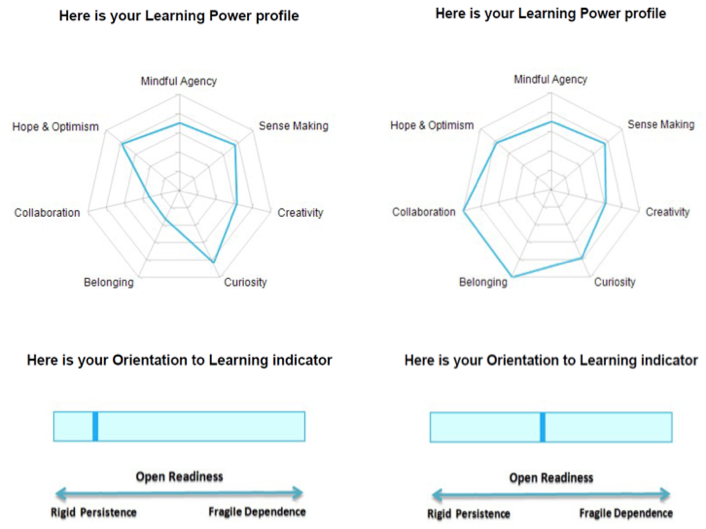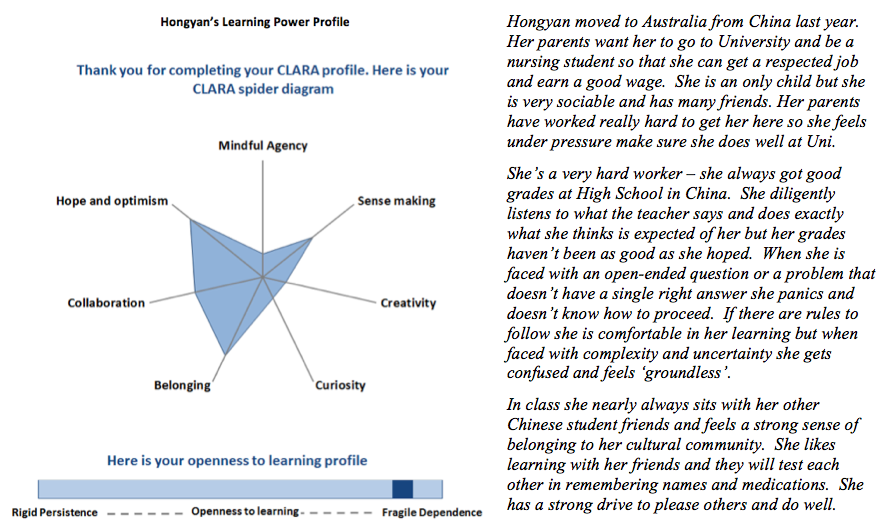Now that the “the only constant is change” in society, our capacity to engage with novel challenges is of first order importance. What are the personal dispositions that authentic learning needs to cultivate, and can we make these assessable and visible to learners and educators?
Learning Dispositions are attracting significant attention within educational research, and refer to the habits of mind that shape a learner’s response to challenge.
The CLARA tool is a research validated survey instrument, designed by Ruth Crick (Professor of Learning Analytics & Educational Leadership, School of Education, Institute for Sustainable Futures, & CIC), and deployed globally in diverse contexts by colleagues, many of whom are part of the Learning Emergence network.
CLARA provides immediate feedback to the survey respondent, to provoke reflection on a multidimensional construct called “Learning Power” with eight dimensions: curiosity, creativity, sense making, belonging, collaboration, hope and optimism, mindful agency and openness to change. The UTS Graduate Attributes are grounded in this research, echoed in direct feedback from employers.
Two examples of the personal spidergram that is generated from CLARA are shown here, which become a springboard for supported reflection and coaching:

Aggregate views provide statistical summaries of a cohort’s profiles. The research behind CLARA and its predecessors demonstrates that naming these essential personal dispositions, and presenting them visually in a way that invites ‘stretching’ oneself on one or more dimensions, can have great impact. As such it resonates closely with Learning.Futures, offering a way to assess hard to quantify student qualities.
At UTS senior student mentors introduce first year students to fictional students and their profiles, based on archetypes of UTS students. An example of an archetypal student and her profile is shown below. These have proven to be an effective vehicle for helping students understand how learning power connects with their own life stories and habits of mind.

At CIC, we and our partners at Incept Labs are investigating not just learners’ dispositions, but the other half of the coin: teachers’ dispositions — the habits of mind and epistemological worldviews that they bring to teaching, which then shapes their practice.
Deployment in UTS
CLARA is being used at UTS in a number of contexts including…
Key references
Deakin Crick, R., S. Huang, A. Ahmed-Shafi and C. Goldspink (2015). Developing Resilient Agency in Learning: The Internal Structure of Learning Power. British Journal of Educational Studies 63(2): 121- 160. Open Access Eprint: http://dx.doi.org/10.1080/00071005.2015.1006574
Deakin Crick, R. & Goldspink, C. (2014): Learner Dispositions, Self-Theories and Student Engagement. British Journal of Educational Studies, pp. 1-17. DOI: http://dx.doi.org/10.1080/00071005.2014.904038. Open Access Eprint: PDF
Buckingham Shum, S. and Deakin Crick, R. (2012). Learning Dispositions and Transferable Competencies: Pedagogy, Modelling and Learning Analytics. Proc. 2nd Int. Conf. Learning Analytics & Knowledge. (29 Apr-2 May, 2012, Vancouver, BC). ACM Press: New York. DOI: 10.1145/2330601.2330629. Open Access Eprint: http://oro.open.ac.uk/32823 (conference replay)
